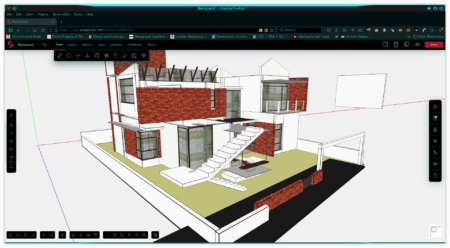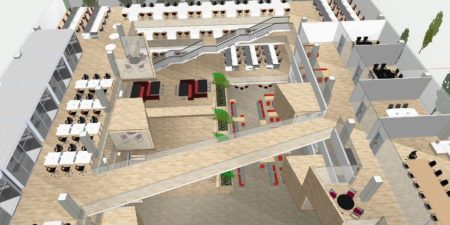Snaptrude is a cloud-based collaborative design tool for architects and interior designers. It is one of several cloud-based design systems that have come to market lately. It is conceptually similar to the Infurnia SaaS (software as a service) design system that Architosh featured recently. That tool we wrote up as a BIM News item, but Snaptrude sits in a different space between SketchUp and Infurnia.
Collaboration
Working as a team is an integral part of the architectural design process. Whether through tabletop design reviews or brainstorming on a whiteboard, architects have always needed ways to share ideas, drawings, and models within their teams.
Snaptrude is engineered so that architects and interior designers can work on their designs and communicate with their teams, in real-time, whilst also receiving real-time feedback from stakeholders. Moreover, users can do this on virtually any modern computer system, Windows, Mac, or Linux, on any modern web browser, from any location in the world, providing it has a reasonably good quality internet connection.
Getting started
Snaptrude is a very powerful design tool. Yet Snaptrude reckons that most architects and interior designers can be productive within a few hours of starting to use it.
Snaptrude’s user interface is clean and responsive. It also offers beginners a number of demonstration models that one can load and edit, in order to get the feel of the product. Anyone can set up a free account on Snaptrude’s site. One just needs to register and then log in.

Snaptrude cloud-based design tool runs on macOS and Windows. This screen capture shows it also runs happily on Ubuntu GNU/Linux. (Image: Snaptrude)
Using Snaptrude certainly seems simple and straightforward. I was able to find my way around the basics within an hour or so of my test account becoming active.
Straightforward navigation in 2D or 3D environments
On Snaptrude, you can work on 3D views or any story’s 2D plan views. Users can quickly toggle between these environments using the ‘View’ button. Working on multistorey projects is much easier now with stories separated into an accessible section. Clicking on a story takes you to the story’s plan.
You can hover on a story to view more options. Click on the arrow that appears when you hover on a story number. The dropdown menu allows users to change story height, and story name, select all the rooms or objects on the story, and even hide the story altogether.
Parametric Components
Users can edit their designs parametrically. Parametric design is a process that uses parameters and rules to define, encode and clarify the relationship between design intent and design response. Put simply, multiple spatial changes on multiple objects can be made by editing just one object.
Parametric design helps Snaptrude users design their buildings and interiors easily. Users can draw rooms and spaces rather than merely drawing a collection of lines or walls. Its drawing tool predicts room shapes based on neighboring rooms, speeding up the process.
Architects may need to edit entire collections of door or window widths, lintel, or sill heights after placing them in the model. Snaptrude’s s parametric design paradigm allows for such changes to be made quickly and easily. Likewise, users can control all wall or slab thicknesses from a central location that updates these parameters across the entire model.
Alternatively, the user may choose instead to change some dimensions for individual objects without affecting other objects. In Snaptrude, the user always has a choice.
Multistoreys
Snaptrude helps architects and interior designers quickly create multistorey buildings with parametrically linked stories. It allows the architects to control multiple floor heights using its ‘Storeys’ feature. Thus users can make rapid changes to their entire model at any point in time.
With Snaptrude there is no need to calculate the position of each story or move them up or down to match the changes. Users can change the height of one story. The system then recalculates all the remaining floor heights automatically.
BIM
Snaptrude cloud-based design tool is also an intelligent BIM (building information modeling) tool but today more of an upfront (schematic design) phase ‘Sketch to BIM’ tool. Every component within Snaptrude has BIM properties attached to it. Thus enabling quick and easy editing of BIM data.
Quoting from Snaptrude’s website:-
“Building Information Modeling (BIM)’ is an intelligent 3D model-based process that gives architecture, engineering, and construction (AEC) professionals the insight and tools to more efficiently plan, design, construct, and manage buildings and infrastructure.”
Traditionally, BIMs are computer files that can be extracted, exchanged, or networked to support decision-making when creating a building. The purpose of BIM is to capture digital representations of the physical and functional characteristics of buildings and their internal components and be able to quickly generate 2D drawing documentation derived from the BIM geometry and data.
Snaptrude isn’t a mature BIM system by any stretch of the imagination. It doesn’t compare in features and capabilities like say Graphisoft’s Archicad or Bentley’s OpenBuildings BIM programs. As a startup in the AEC space, Snaptrude aims to complement existing stalwarts in the AEC software system as a design-stage BIM system in the cloud, with the cloud’s native advantages giving it superpowers that desktop BIM systems lack specifically at the design stage.
One such superpower is multiple participants (designers and non-designers) can access and engage with a Snaptrude model in real-time, regardless of geographical location. Another superpower coming from the cloud is users can work with Snaptrude with the computer system of their choice—macOS, Linux, Windows, and within their favorite web browser of choice. Here at Architosh, we refer to this as the “democratization of tools and data”—an overarching good for everybody living and working in the digital era.
Export to Revit
Snaptrude is releasing a completely updated ‘Export to Revit’ feature. Now users can export any design made on Snaptrude into Autodesk Revit in (.rvt ) file format. Snaptrude reckons that walls, slabs, staircases, flooring, doors, and windows created with Snaptrude from its built-in library can now be faithfully recreated in Revit. Unlike an (.ifc) export, the export in (.rvt) format means that the model should be fully editable in Revit.
Usage
Snaptrude is growing quite rapidly. Figures from 2021 indicate that despite COVID, over 10 million square feet or just under a million square meters of floor space was created using its product. Snaptrude also estimates that 4500 new users joined its userbase during that time.
Pricing
Snaptrude has three price plans, entitled Free, Professional, and Organization. Readers can learn more about them online here.
For more information and a free demonstration please click here.
About Snaptrude
Designed in India, Headquartered in New York, and founded on 1 December 2017, Snaptrude Inc. is the brainchild of its current CEO, Altaf Ganihar.





Reader Comments
Comments for this story are closed